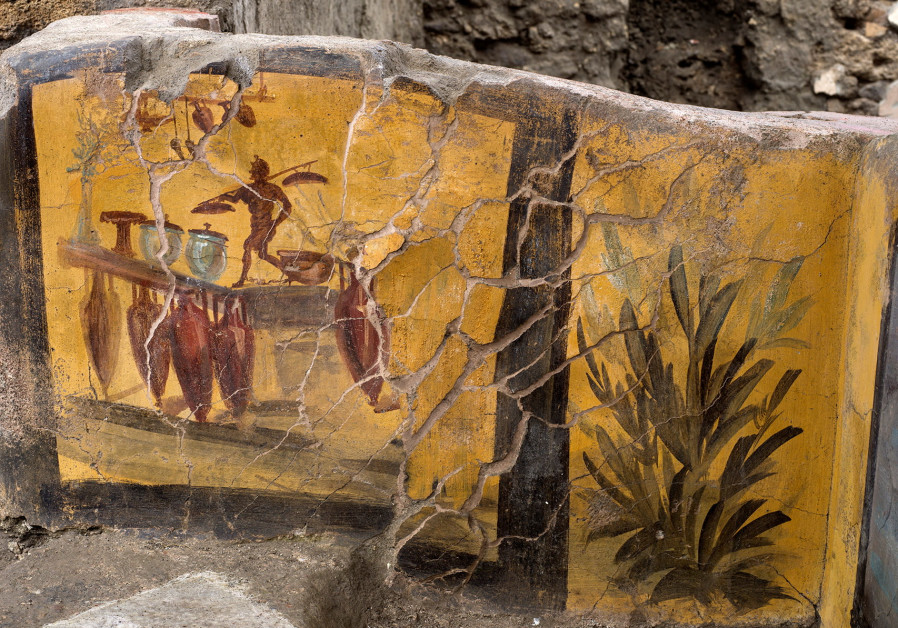Archaeologists in Pompeii, the city buried in a volcanic eruption in 79 AD, have made the extraordinary find of a frescoed hot food and drinks shop that served up the ancient equivalent of street food to Roman passersby.
Known as a termopolium, Latin for hot drinks counter, the shop was discovered in the archaeological park’s Regio V site, which is not yet open the public, and unveiled on Saturday.
The ornate snack bar, decorated with polychrome patterns and frozen by volcanic ash, was partially exhumed last year but archaeologists extended work on the site to reveal it in its full glory.
Traces of nearly 2,000-year-old food were found in some of the deep terra cotta jars containing hot food which the shop keeper lowered into a counter with circular holes.
The front of the counter was decorated with brightly colored frescoes, some depicting animals that were part of the ingredients in the food sold, such as a chicken and two ducks hanging upside down. Archaeologists discover ancient ‘Street Food Shop’ – Pompeii (Credit: REUTERS)
Archaeologists discover ancient ‘Street Food Shop’ – Pompeii (Credit: REUTERS)
 Archaeologists discover ancient ‘Street Food Shop’ – Pompeii (Credit: REUTERS)
Archaeologists discover ancient ‘Street Food Shop’ – Pompeii (Credit: REUTERS)“This is an extraordinary find. It’s the first time we are excavating an entire termopolium,” said Massimo Ossana, director-general at the archaeological Park of Pompeii.
“As well as bearing witness to daily life in Pompeii, the possibilities to analyse afforded by this thermopolium are exceptional because for the first time we have excavated a site in its entirety,” added Osanna.
The Thermopolium of #RegioV, a bar in #Pompeii, complete with an image of a Nereid riding a sea-horse, had previously been partially excavated in 2019. It now emerges in its entirety, with rich decorative still life frescoes, food residues, animal bones & victims of the eruption. pic.twitter.com/OEqh2sbAmm— Pompeii Sites (@pompeii_sites) December 26, 2020
Archaeologists also found a decorated bronze drinking bowl known as a patera, ceramic jars used for cooking stews and soups, wine flasks and amphora.
Pompeii, 23 km (14 miles) southeast of Naples, was home to about 13,000 people when it was buried under ash, pumice pebbles and dust as it endured the force of an eruption equivalent to many atomic bombs.
“Our preliminary analyzes shows that the figures drawn on the front of the counter, represent, at least in part, the food and drink that were sold there,” said Valeria Amoretti, a site anthropologist.
Amoretti said traces of pork, fish, snails and beef had been found in the containers, a discovery she called a “testimony to the great variety of animal products used to prepare dishes.”
About two-thirds of the 66-hectare (165-acre) ancient town has been uncovered. The ruins were not discovered until the 16th century and organized excavations began about 1750.
A rare documentation of Greco-Roman life, Pompeii is one of Italy’s most popular attractions and a UNESCO World Heritage Site.
The thermopolium—the word comes from the Greek “thermos” for hot and “poleo” to sell—was very popular in the Roman world and the city of Pompeii alone had around 80.
Related posts:
The West has allowed Turkey to be a massive base for ISIS: UK analyst
How P2P Crowdfunding Is Disrupting Wall Street
The Mûmakil Elephant Slayers Of The Ancient World
BlackRock, State Street Admit Signing Net-Zero Pledges They Don’t Act On
Ancient Alchemical Esoteric Art That Leaves Humanity Clues About The Nature of Consciousness
Ramayana: The Grand Epic of Ancient India
 RSS Feed
RSS Feed















 December 28th, 2020
December 28th, 2020  Awake Goy
Awake Goy  Posted in
Posted in  Tags:
Tags: 













